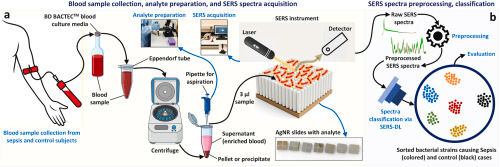New Publication: Quantitative Insights into Virus Adsorption and Co-adsorption using SERS
- Yiping Zhao
- Aug 25, 2025
- 2 min read
We’re excited to share our latest article in The Journal of Physical Chemistry A, published in the Michael A. Duncan Festschrift special issue: 👉 “Quantitative Analysis of Virus Adsorption and Co-adsorption Behavior Using BET Modeling and SERS Spectroscopy” (DOI link) .
🔍Why It Matters
Virus–surface interactions are critical to understanding infection pathways, biosensor performance, and environmental monitoring. While many studies focus on single-virus adsorption, real-world samples often involve multiple viruses interacting simultaneously. Our work provides the first quantitative, mixture-aware framework for describing these adsorption dynamics using SERS spectroscopy combined with a modified Brunauer–Emmett–Teller (BET) model.
🧠Main Contributions
Comprehensive Virus Panel: Studied 12 clinically relevant respiratory viruses, including influenza (H1N1, H3N2, Flu B), RSV, adenovirus, and coronaviruses, in both water and human saliva.
SERS + BET Modeling: Applied linear spectral decomposition and BET modeling to extract adsorption coefficients and constants that quantify virus binding strength and cooperativity.
Single-Virus Adsorption: All viruses showed multilayer physisorption (Type II isotherms), but adsorption strength (BET constant q) varied dramatically—e.g., RSV-A2 (q = 120) vs. H3N2 (q = 12).
Mixture Effects: Binary virus mixtures (e.g., influenza + RSV) showed strongly enhanced adsorption, with q values 4–25 times greater than single-virus cases—revealing cooperative or competitive effects.
Physiological Matrix Impact: Saliva shifted adsorption energetics in virus-specific ways—suppressing some interactions (Flu B, RSV-A2) while enhancing others (H1N1, H3N2).
💡What Sets This Work Apart
This is the first systematic study to quantitatively describe both single-virus and co-adsorption behavior across multiple respiratory viruses using SERS. By linking adsorption constants with virus type, environment, and mixture state, the work highlights why single-virus calibration often fails in real diagnostic contexts.
🔭Looking Ahead
Our framework opens new directions for mixture-aware biosensing, with implications for:
Coinfection diagnostics: accounting for virus–virus interactions in saliva or nasal swabs.
Surface-based detection design: optimizing substrates for stronger, more selective adsorption.
Environmental monitoring: improving predictive models of virus persistence and transport.
📌Citation:Cui, J.; Yang, Y.; Kumar, A.; Murray, J.; Jones, L.; Chen, X.; Tripp, R. A.; Zhao, Y. Quantitative Analysis of Virus Adsorption and Co-adsorption Behavior Using BET Modeling and SERS Spectroscopy. J. Phys. Chem. A 2025, 129 (34), XXXX–XXXX. https://doi.org/10.1021/acs.jpca.5c03375






Comments